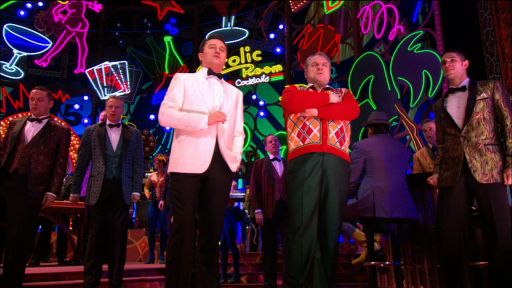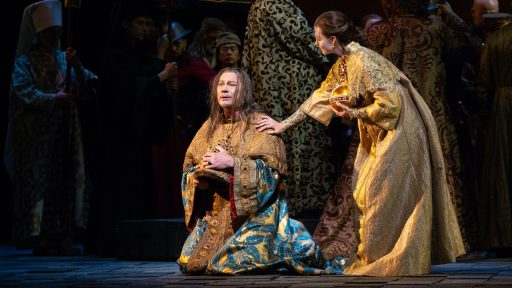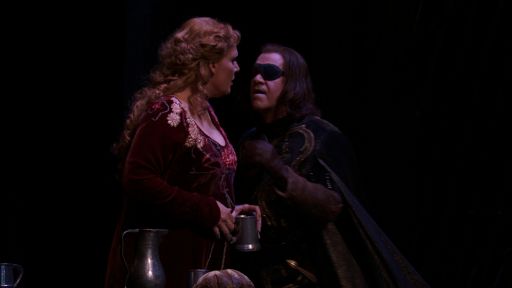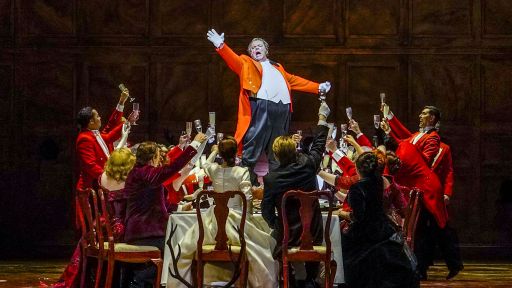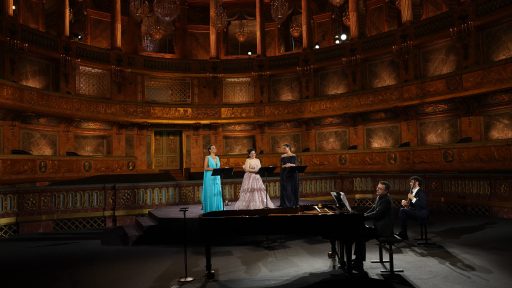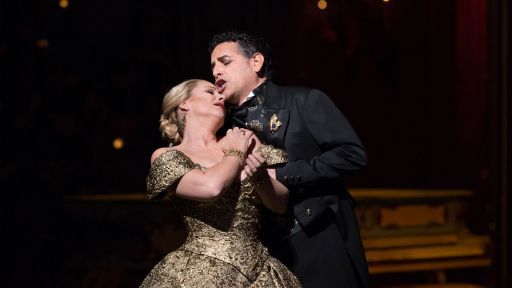Paul Cremo of the Metropolitan Opera tells us what it’s like to be a dramaturg and the specific challenges and rewards of modernizing the titles for Michael Mayer’s new production of Rigoletto, set in 1960s Las Vegas, which some audience members are calling the “Rat Pack Rigoletto.”
What is a dramaturg?
Most US opera houses don’t have a Dramaturg. The Met never had one until I was hired seven years ago. Dramaturgs can get involved with all sorts of tasks at a theater or opera house, many of which I actually don’t do at the Met (things like historical research for the cast or writing program notes or research for the director or setting up panel discussions). As Dramaturg/Director of the Opera Commissioning Program, my biggest responsibility is overseeing a workshop program for developing new operas. This is a joint venture with Lincoln Center Theater in which we pair composers and playwrights to write new works and help the creators to develop them through a workshop process. The first work from this program, TWO BOYS by Nico Muhly and Craig Lucas, will premiere at the Met this October. For projects like TWO BOYS, I read through drafts, give notes, discuss and produce workshops in which new material is tried out. It’s basically like being a book editor, mixed with producer and a bit of midwife.
In addition to the workshop pieces (which may not proceed beyond the workshop phase), I am involved with the development of works that are commissioned directly for the Met stage, such as ENCHANTED ISLAND, which was created by Jeremy Sams and premiered in 2011 and was shown on Great Performances at the Met last year. I’m currently working with Sams on our English language version of DIE FLEDERMAUS, which will have its premiere at the Met this New Year’s Eve. In all of these projects, my job is to oversee the development of the piece, providing feedback and guidance to the creators in order to help them tell their story in as dramatically effective and entertaining a way as possible. I also work with the other departments at the Met to make sure they have the information they need to do their jobs regarding these new projects, whether it’s the orchestra, stage management, directing staff, casting, publicity or marketing departments..
Another of my responsibilities involves overseeing the editorial content of the Met Titles, the Met’s subtitling system. I work with Mike Panayos, the Met Titles supervisor, sitting in on rehearsals and watching the interplay of the production on stage with the titles, which appear on small screens on the auditorium seat backs. Again, my job is to make sure the titles tell the story as clearly and succinctly as possible. The goal is to get across the important information and coordinate with the stage action and the tone of the production to help support the director’s vision and tell the story effectively, and to allow the audience to keep their eyes onstage as much as possible. After rehearsals, Mike and I sit together and work through our notes and exchange ideas for rewrites and eventually hammer out revisions as needed. We also discuss the timing and placement of titles—we don’t title every single word so we have to decide when to skip, condense or cover particular bits of text. If there’s a piece of physical business onstage, we don’t want to have anyone miss it because they’re reading their title screen, so we’ll go black at that moment, cueing people to look up.
How does one become a dramaturg?
There are undergraduate and graduate programs in Dramaturgy but just as often Dramaturgs come from general theater, directing or writing backgrounds. My background is actually in film and theater; my studies and various jobs have always centered on storytelling in one way or the other. I was always involved in music as a sideline, and now this job allows me to combine all these aspects in one position.
What’s the process of turning a libretto into a supertitle transcript?
We hire titles writers to translate the work from the original language into English (which has to fit on our screens—38 characters across, two lines). The titlists have to know the original language, be adept at thinking up concise ways of conveying those ideas in English and also read and understand music. In addition to the actual translation, they have to create a cued score—they place marks in the musical score to indicate when a title should appear at a given point in the music, and when it should fade out or go to black. These cues are numbered and matched to the individual cues in a titles script, which is simply a running list of numbered, individual cues from the start to the end of the opera. A cue caller watches the performance as it happens, following the score and calling out the number of each cue at the appropriate musical beat, and the titles operator presses a button to make the title appear on the screens in the auditorium. Arriving at the precise wording and timing of these cues is an art in itself, and requires weeks of work. Once a titles writer gives us a first draft of a titles script, the Met Titles team—Mike Panayos, Cecilia Sparacio and me—watches daily rehearsals and makes notes and changes to the titles based on what we see. We’re always aiming for greater clarity, effective dramatic underlining of moments, capturing the right tone, and we try to not give away information too soon, spoil punch lines or distract from important stage action. It’s actually an incredibly complicated process and we continue to refine the wording and timing of the titles even beyond opening night. Operatic performances are fluid things, and different singers or conductors can change the performance –and the way titles work—to a great degree, particularly when it comes to timing and tempos.
When working on titles, do you aim for more direct translation or more poetic language that syncs with the music?
The translator aims to make the text as simple as possible, so it can be read quickly and the viewer’s eyes can get back to looking at the stage action. That said, we like to try to convey some sense of the style of the original language—Wagner’s faux-archaic fairly tale language, or in this past season, the over the top romanticism of Francesca di Rimini, or the jokey tone of Il Barbiere di Siviglia. Ideally, people will just read the titles, watch the stage and listen to the music and it will meld into one experience, with the titles not calling too much attention to themselves. Some people even say that after a while, they start to imagine they’re understanding the original foreign language as they read along; they stop thinking about reading a translation. Of course, due to space and time limitations, we can’t translate every single word, or take the time and space to explain every complex idea in the titles. The Ring Cycle titles create quite a challenge in this regard, as the text is quite dense, complex and philosophical. All we can do is try to convey the clearest sense of the text possible and realize that each title disappears quickly, and the audience member is then on to the next one—it’s not like reading a printed libretto or a CD booklet libretto, where you can refer back to clarify and match line for line with the original text. Titles are a different animal and they meant to give those who don’t know the libretto word for word a sense of what’s happening–as much as we can, given the limitations of time and space and the system.
Are certain operas or eras of opera easier to transcribe than others?
We live in a very savvy age in terms of drama and storytelling, and people are very hip to conventions and very sensitive to anything that smacks of contrivance or overstatement. Well, since that sort of sums up the plots and languages of a lot of operas, we try to steer clear of anything that will underline the plot elements or language that people might find mildly laughable or contrived today. Verdi has his share of hard to swallow plot turns (brothers not knowing they’re brothers and the like, people choosing to die for honor’s sake, etc.) so they can be challenging to title for today’s audiences, who can be quick to laugh at something they recognize as a bit over the top or unbelievable (cf. Ernani). By contrast, something like Eugene Onegin is for the most part a very believable, naturalistic story, told simply and in a very focused way. Its text, when it’s not being especially flowery, insightfully tells a story to which we can easily relate. That makes writing the titles easier; we don’t have to turn ourselves inside out trying to downplay somewhat ridiculous plot turns, or attempt to convey the sense of epigrams, aphorisms and philosophical musings of the sort which fill the librettos of The Ring. The Mozart –DaPonte operas are challenging to title just because the recitative rattles along so quickly, and we can’t title everything that’s sung (since we don’t want the audience with their eyes on the titles screens all the time, missing the delightful action onstage). However, what these characters actually say is so timeless, wise, funny and human that it is easy to express in English, even in the condensed form required for Met Titles. The truths DaPonte wrote about, whether in Figaro or Cosi, still ring true today. Operas with lots of repeats (Handel, some Verdi) can be challenging because seeing the same text over and over can seem boring or even silly, yet if we hesitate to go dark too much because some people may become concerned that they’re missing something (or that their titles screen has broken down!).
How did the decision to “modernize” Rigoletto’s translations come about?
Michael Mayer’s concept for the production was to set the opera in 1960 Las Vegas. He thought it out very carefully, making sure all the relationships, power dynamics and sense of a social milieu matched up with the original—a world in which one man can have power over many sycophantic hangers-on, in which women are treated as objects, prey or spoils, in which honor and pride rule and power is everything. Once we saw the splashy modern designs and got a sense of how the action would be updated–with a flashy casino set, 60’s costumes, a Cadillac and Act III set in a seedy sex club–we realized that the usual Met Titles used for our previous, traditional production (the opera is originally set in 16th century Mantua) would read as overly flowery and not in keeping with the tone of this new production. Mike Panayos and I went through the old translation by Sonya Friedman line by line and revised the titles, asking how these characters in this time period and setting would say certain lines, how they’d express themselves in the idioms of that time. We showed a draft to Michael Mayer and he loved it—he encouraged us to really push the envelope in having the characters’ lines read the way their 1960’s counterparts might actually sound.
Do you think the production would still be effective had the translations not been updated?
I think the contrast between the more formal, flowery titles of the 16th century production would have clashed with the 1960-set production, taking the audience out of the action by underlining the distance between the original setting and the new. Instead, we wanted to close that gap as much as possible, to work with the production instead of against it. Mike Panayos and I felt our revised titles supported Mayer’s production and helped keep the audience in the reality of the world Michael and his creative team summoned through design elements and direction. The first line of the opera, the Duke’s, was translated in the old production as, “I must seduce that young beauty.” Now that just wouldn’t work for the cool, swinging Sinatra-esque figure in the new production. So we revised the title to read, “I’ve got to find a way to get that girl.” Similarly, when the Duke then sings “Questa o quella,” wearing a white dinner jacket and holding a microphone, it seemed clear that the titles should read like a 50’s Sammy Cahn-Jimmy Van Heusen pop song, the kind Sinatra recorded for Capitol records. So instead of “One woman or another…to me, they’re all the same,” we came up with “This girl or that girl, I’ll give any girl a whirl.” It seemed to fit with the way the scene was staged and acted while conveying the same idea about the Duke’s philosophy.
What has been the audience response or reaction to the updated production and the specific choice to modernize the title language as well?
Some purists were put off by the titles, but for the most part audiences loved them. There were laughs and gasps and moments of rapt silence (as in Gilda’s first scenes with Rigloletto and the Duke and Rigoletto’s first scene with Sparafucile) in which we could tell they were really following the story and were buying into it, thanks mostly to the terrific production and great performances, but also in some part to the way the titles matched the action and milieu of this production.
Do you think people’s familiarity with Rigoletto’s story and libretto helped or hurt creating such a new take on the piece?
I think any time you see an opera you’re very familiar with you have to will yourself to forget what you know to a certain extent, if you really want to go along for the ride. If you don’t—if you want to sit back with your arms folded–nothing is going to change that mindset. But if you feel the production—no matter where or when it’s set—resonates with you, if the director gains your trust by presenting his take with the attitude that he or she wants to share his ideas and enthusiasm for the work, to truly make you feel its drama, then you’ll get pulled into it and your knowledge of the piece won’t be a hindrance. For those who know the piece, I think it was entertaining to see how Mayer solved certain challenges and how he addressed certain issues. I’ve spoken with people who have seen plenty of traditional productions and so know the piece well, but who appreciated a new look at it—several people told me they found they understood the opera in a whole new way, and felt it in a deeper, more immediate way, in this production. Some of what may seem like contrivances in the plot—the usual business with the ladder the courtiers use to get into Rigoletto’s house and to confuse him into thinking they’re breaking into Ceprano’s house, the business of blindfolding him in the same scene and yet he somehow doesn’t realize it and just thinks it’s really dark—those things were solved quite cleverly, elegantly, and believably in Mayer’s use of the elevators in the abduction scene and elsewhere.
What’s a scene in this new production where you think the new titles work perfectly?
The scene in which Rigoletto talks to Sparafucile about how he works as an assassin. I think we captured the mood of the scene while using the lingo of the 1960 time period in a clear, natural and even humorous way, and conveyed the creepy, after hours tough-guy feel of the scene—while actually staying very close to what is actually being sung in Italian, just translated a bit into the slang of the day. I think the audience followed the contours of that conversation very closely, which strongly supported the brilliant performances of Željko Lučić and Štefan Kocán. We tried to think of the titles for that scene as dialogue, with a naturalistic, conversational quality, and after the splashy opening scenes in the casino, this brought the story down to a more intimate, human level that really served the piece. In the old Rigoletto production, he asks Sparafucile about a hypothetical killing, “How much would you charge if he were a nobleman?” For the new production, we revised the title to read, “What if the guy was a big shot? How much would that be?” The meaning is the same, and quite clear, and the line stresses the resentment of power which is at the heart of the story. Overall, the most satisfying scenes in the opera, from a titles point of view, were the ones in which we stayed as close to the Italian meaning as possible, but just dressed the line a bit differently while keeping the underlying idea the same. Many people felt this helped pull them into the story in a more powerful way than usual.
What’s a scene that was particularly challenging to bring to 1960s Las Vegas?
Definitely the scene where Monterone curses Rigoletto. If the language seemed too purple, too over the top, it made him seem ridiculous. But if the language wasn’t strong, the curse would seem meaningless. We tried to focus on the real, righteous anger Monterone feels about his daughter’s ill treatment by the Duke and the courtiers and make the language emotional without being too melodramatic. The fact that he is portrayed in this production as a Sheik—which was done I think as a way to give his character some element of exotic power that might actually get under Rigoletto’s skin and torment him—also had to be taken into consideration. What would this version of the character say, how would he say it? This language couldn’t be slangy, it had to be more timeless and emotion-based, not cool.
What’s your favorite kind of music to listen to outside of work?
Standards. The great American songbook. If I start listening to Jonathan Schwartz on Sunday afternoon on WNYC, I can’t leave my apartment because I get caught up in sampling all the great songs and singers he plays…

